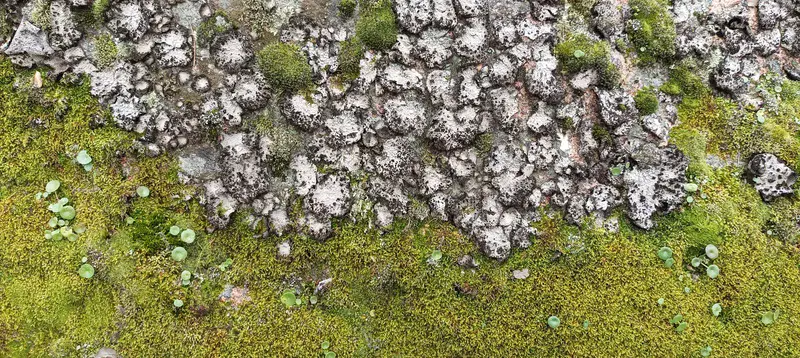
Lichens and mosses covering the surface of a granite rock in a cork oak forest
by Antonio Jordán, University of Seville, Sevilla, Spain
First, in English:
The photograph shows a crust of lichens on granites north of Seville (SW Spain), in a cork oak forest. Lichens are the result of the symbiotic relationship between an algae and a fungus. They are present in almost all known ecosystems. They are capable of adapting to a very wide range of environments as well as extreme weather conditions.
Separately, the two types of organism that unite in the lichen (algae and fungus) could not colonize these systems, but the relationship between them does allow it. For this reason they are considered among the first colonizers of the rock and play a fundamental role in weathering and soil formation.
You can get some more information about the biology and role of lichens as colonizers here: https://imaggeo.egu.eu/view/17069.
The lichens in the image are crust-like or custrose, because they grow very tightly attached to the substrate (in this case, a rock). Crustose lichens can present very diverse morphologies. In this case, darker edges are shown. Lichen taxonomy is not my area of expertise (if any), so I encourage people more knowledgeable than me to post their comments.
You can read more about biological crusts on my blog (in Spanish: https://gsoil.blogspot.com/2025/03/costras-biologicas-la-vida-que-cubre-el.html)
Ahora, en español:
La fotografía muestra una costra de líquenes sobre granitos al norte de Sevilla (SO de España), en un alcornocal. Los líquenes son el resultado de la relación simbiótica entre un alga y un hongo. Están presentes en casi todos los ecosistemas conocidos. Son capaces de adaptarse a un rango muy amplio de ambientes así como a condiciones climáticas extremas.
Por separado, los dos tipos de organismo que se unen en el liquen (alga y hongo) no podrían colonizar estos sistemas, pero la relación entre ellos sí lo permite. Por esta razón son considerados entre los primeros colonizadores de la roca y desempeñan un papel fundamental en la meteorización y la formación del suelo.
Puedes obtener algo más de información sobre la biología y el papel de los líquenes como colonizadores aquí: https://imaggeo.egu.eu/view/17069.
Los líquenes en la imagen son de talo costroso, porque crecen unidos muy fuertemente al sustrato (en este caso, una roca). Los líquenes costrosos pueden presentar morfologías muy diversas. En este caso se muestran bordes más oscuros que el resto. La taxonomía de los líquenes no es mi fuerte (si es que hay alguna que lo sea), así que animo a gente más sabia que yo a publicar sus comentarios.
Puedes leer más sobre costras biológicas en mi blog (https://gsoil.blogspot.com/2025/03/costras-biologicas-la-vida-que-cubre-el.html)
Categories
Location
- Europe (3885)
- Southern Europe (1685)
- Spain (813)
- Exact location (-6.0454 W, 37.8433 N)
Tags
- mediterranean soils (267)
- forest soil (152)
- lichen (22)
- forest (54)
- granite (24)
- rock (50)
- moss (16)
- microbiotic crusts (44)
Colours
Image properties
4000 × 1792 px;
image/jpeg; 2.3 MB
Camera:
Xiaomi M2103K19G
Taken on 11
March
2023
Submitted on 4 April 2023
Licence
Creative Commons Attribution-ShareAlike 3.0 Unported (CC BY-SA 3.0)
Credit
Antonio Jordán (distributed via imaggeo.egu.eu)
Share
Appreciate
Report